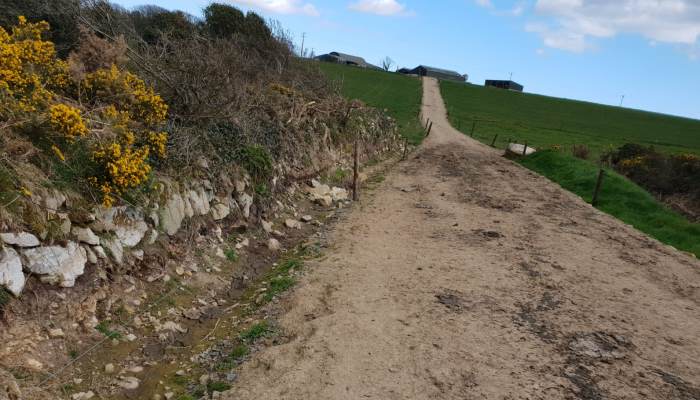16 October 2021
Building a Farm Roadway

A well-designed, carefully built and properly maintained farm roadway system has many benefits, including, less lameness, faster and easier stock movement, less roadway maintenance, more efficient paddock access and more as Tom Fallon, Farm Buildings & Infrastructure Specialist outlines here.
The benefits also include better general animal health, and it keeps runoff away from dry ditches and watercourses. For dairy farms, this also includes less mastitis, cleaner cows and milk with lower sediment and thermoduric levels. The maintenance of roadways near the farmyard is often challenging; concreting a section of the roadway in this scenario is sensible but you must keep stones off this concrete!
Roadway width
The width of roadways depends on the number of livestock in the herd. Guidance on standard widths is given below. Roadway width is not an exact science – cows cannot be rushed regardless of road size. Add 1m of width for the stretch of roadway nearest the farmyard. The fence should be positioned about 0.5m from the edge of the roadway.
Care in removing topsoil
The topsoil will deform under the weight of machinery so it is best to remove a 10 to 15cm layer of topsoil. It is important not to remove too much because 80% of the cost of the road is the material (stone and blinding). The final road surface must be above field level.
Fall on the road surface
Achieving a fall on the finished surface is probably the biggest weakness in road construction. Roads must shed water to reduce the risk of pothole development. The recommended fall across a roadway (crossfall) is 1 in 25, therefore a 4m wide road must be 160mm(4,000/25) higher on one side than the other. Of course if the fall is from the centre it can be 80mm higher in the middle. Depending on the strength of the underlying soil and any extra load factors such as the slope of the roadway a depth of hardcore of 200-300mm on one side and 360 to 460mm on the other side should be adequate.
After levelling the stone, use a heavy vibrating roller (normally about 8 tonne) to compact.
Dust or blinding
A 25mm (one inch) layer or dust or blinding should be adequate, if the dust is too deep it can come away with tractor wheels, it can also be washed down slopes etc. Ideally spread the dust in damp weather to help it bind in better. A ‘4 in 1 bucket’ can be useful to sprinkle it on.
Roll again with the vibrating roller after applying the dust.
Please note that some quarries sell the dust already added to the stone, T1 stone (formerly labelled 804 stone) or 40 to 50mm stone with the T3 blinding. Using a vibrating roller on this material will bring the dust to the surface.
Consider using Geotextile to support the road in boggy ground. It can also be an alternative to taking away the sod in that the Geotextile is placed on the sod and the road is built from there.
Choice of stone
Shale tends to be flat so it is easy to bed in. It is also relatively soft and so it is comfortable for cows to walk on. It can however deteriorate over time especially from machinery traffic. The minimum amount of dust or blinding should be used with shale.
Limestone is harder on animals feet but it gives a more durable road for machinery.
Sandstone is intermediate between shale and limestone in terms of hardness and is ideal for farm roads. Greywacke is somewhat harder than typical sandstone and it is often used on farm roads.
Planning a new farm road
- Talk to your adviser or consultant on location, protecting waters etc.
- Appoint Project Supervisors as required by the Health & Safety Authority.
- Roadways are costly so do a budget and take care with the depth of soil removed etc. The compacted stone and blinding will have a density of approximately 2 tonne/m3.
- Build your roadway in dry conditions.
Watch as Tom Fallon demonstrates how to build a farm roadway in the video below
For more information see: The Farm Roadway Visual Assessment Booklet
You can contact any of our Teagasc offices to get more advice from Teagasc advisors using this link Teagasc Advisory Regions here
